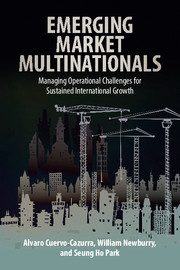Book contents
- Frontmatter
- Dedication
- Contents
- List of figures
- List of tables
- Foreword
- Preface
- List of abbreviations
- 1 Introduction: the rise of EMNCS
- 2 Understanding the challenges of internationalization
- 3 Country selection
- 4 Entry mode selection
- 5 Establishment
- 6 Operation
- 7 Integration
- 8 Expansion
- 9 Conclusions
- References
- Index
7 - Integration
Published online by Cambridge University Press: 05 March 2016
- Frontmatter
- Dedication
- Contents
- List of figures
- List of tables
- Foreword
- Preface
- List of abbreviations
- 1 Introduction: the rise of EMNCS
- 2 Understanding the challenges of internationalization
- 3 Country selection
- 4 Entry mode selection
- 5 Establishment
- 6 Operation
- 7 Integration
- 8 Expansion
- 9 Conclusions
- References
- Index
Summary
INTRODUCTION
After overcoming the initial tasks of establishing a subsidiary within a foreign country, and often simultaneously, managers of EMNCs must address governance issues to ensure the integration of the new operation with the rest of operations in the multinational. Managing the relationships between HQ and their overseas subsidiaries, along with the optimal management and integration of MNC networks, is a major concern for MNCs. The integration of foreign subsidiaries is also a major area of importance for developed country MNCs, but some specific characteristics make this a particularly problematic area for EMNCs. Inefficiencies caused by organizational structures developed to compensate for the deficiencies in institutions and market intermediaries in the home country, the so-called institutional voids, along with limited capabilities in corporate governance, make integration issues within EMNCs troublesome. These compound the relationship between the foreign subsidiary and the parent corporation. Effective integration includes identifying the mandate of the local operation and its relationship with HQ and other subsidiaries – in other words, how the subsidiary fits within the overall MNC network.
There are additional governance challenges that EMNCs tend to face because of their state and family ownership. For example, some large EMNCs have inherited the bureaucratic structures of their original state-owned enterprises (SOEs), which may complicate the management of overseas subsidiaries. Issues of current government ownership and legacies of recent government ownership are much more prevalent in emerging markets than in developed countries, where they tend to be associated with only a few select industries. Additionally, family-run enterprises, another major component of the emerging market landscape, can also have organizational structures that stifle overseas managers.
Hence, in this chapter, we examine the integration of the new subsidiary within the network of subsidiaries of the EMNC. Specifically, we analyze integration between the subsidiary and HQ and throughout the firm's broader intersubsidiary network, as well as coordination with alliance partners and acquisitions. We also discuss governance issues relating to organizational ownership by the state or family-owned business groups.
OPENING CASE: HAIER'S ACQUISITION OF SANYO
The acquisition of the Japanese Sanyo's white goods operations by the Chinese white goods manufacture Haier illustrates the difficulties EMNCs face in establishing subsidiary roles and controlling overseas operations effectively. The Haier group operated a global network of subsidiaries producing home appliances and consumer electronics.
- Type
- Chapter
- Information
- Emerging Market MultinationalsManaging Operational Challenges for Sustained International Growth, pp. 141 - 161Publisher: Cambridge University PressPrint publication year: 2016

